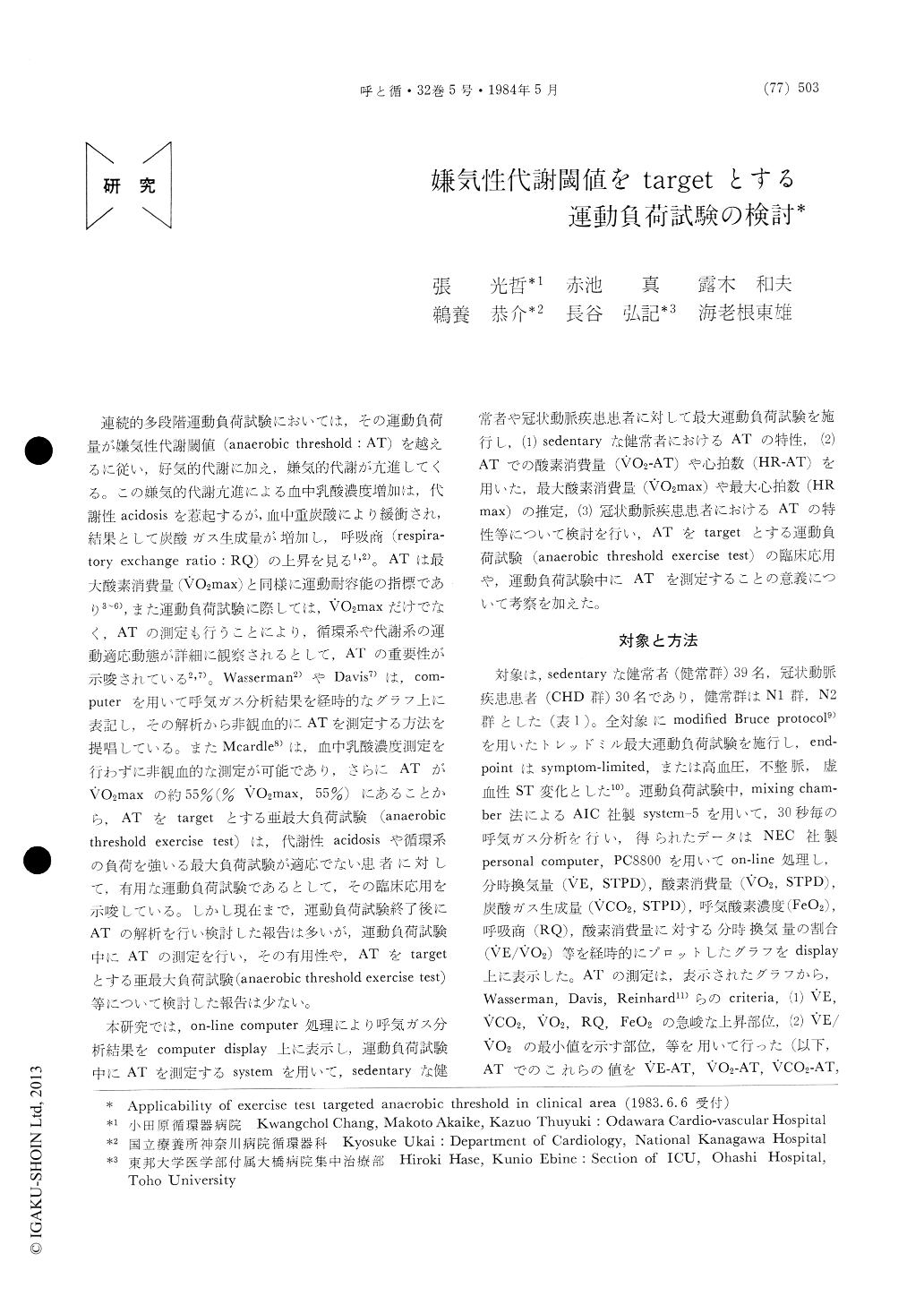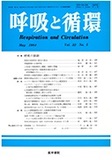Japanese
English
- 有料閲覧
- Abstract 文献概要
- 1ページ目 Look Inside
連続的多段階運動負荷試験においては,その運動負荷量が嫌気性代謝閾値(anaerobic threshold:AT)を越えるに従い,好気的代謝に加え,嫌気的代謝が亢進してくる。この嫌気的代謝亢進による血中乳酸濃度増加は,代謝性acidosisを惹起するが,血中重炭酸により緩衝され,結果として炭酸ガス生成量が増加し,呼吸商(respira—tory exchange ratio:RQ)の上昇を見る1,2)。ATは最大酸素消費量(VO2max)と同様に運動耐容能の指標であり3〜6),また運動負荷試験に際しては,VO2maxだけでなく,ATの測定も行うことにより,循環系や代謝系の運動適応動態が詳細に観察されるとして,ATの重要性が示唆されている2,7)。Wasserman2)やDavis7)は,com—puterを用いて呼気ガス分析結果を経時的なグラフ上に表記し,その解析から非観血的にATを測定する方法を提唱している。またMcardle8)は,血中乳酸濃度測定を行わずに非観血的な測定が可能であり,さらにATがVO2maxの約55%(%VO2max,55%)にあることから,ATをtargetとする亜最大負荷試験(anaerobicthreshold exercise test)は,代謝性acidosisや循環系の負荷を強いる最大負荷試験が適応でない患者に対して,有用な運動負荷試験であるとして,その臨床応用を示唆している。しかし現在まで,運動負荷試験終了後にATの解析を行い検討した報告は多いが,運動負荷試験中にATの測定を行い,その有用性や,ATをtargetとする亜最大負荷試験(anaerobic threshold exercise test)等について検討した報告は少ない。
本研究では,on-line computer処理により呼気ガス分析結果をcomputer display上に表示し,運動負荷試験中にATを測定するsystemを用いて,sedcntaryな健常者や冠状動脈疾患患者に対して最大運動負荷試験を施行し,(1) sedentaryな健常者におけるATの特性,(2)ATでの酸素消費量(VO2—AT)や心拍数(HR-AT)を用いた,最大酸素消費量(VO2max)や最大心拍数(HRmax)の推定,(3)冠状動脈疾患患者におけるATの特性等について検討を行い,ATをtargetとする運動負荷試験(anaerobic threshold exercise test)の臨床応用や,運動負荷試験中にATを測定することの意義について考察を加えた。
The purposes were (1) to evaluate the anaero-bic threshold (AT) in normal sedentary subjects and coronary artery disease patients (CHD pa-tients) ; (2) to investigate the validity of AT detec-tion during exercise test ; (3) to investigate the ap-plicability of the exercise test targeted AT (AT ex-ercise test) in clinical area.
In normal 39 sedentary subjects and 30 CHD pa-tients, symptom limited exercise test were perform-ed, while respiratory variables were graphically plotted against time on computer display and ATs were determind.
The correlation between VO2max and VO2 at AT, between HRmax and HR at AT were signifi-cant (r=0.730, r=0.558). These relationship could be used for predictive purposes. The correlation be-tween measured VO2max and predicted VO2max, measured HRmax and predicted HRmax were significant (r=0.924, r=0.724). Since exercise test targeted AT is detectable AT, and predictable VO2max and HRmax without significant degree of metabolic and cardio-vascular strain, it is useful for the subjects having no indication of maximal exercise test. In CHD patients with AT, the average value of AT was 15.75 ml/kg/min. of VO2 (4.5 METs). In CHD patients without AT, the average value of VO2max was 13.87 ml/kg/min. (3.96 METs). Since AT exercise test target the AT of 4.5 METs, it seemed useful for discharge graded ex-ercise test performed at the end of early cardiac rehabilitation (phase 1).

Copyright © 1984, Igaku-Shoin Ltd. All rights reserved.


